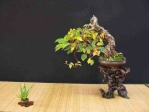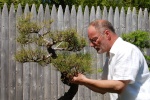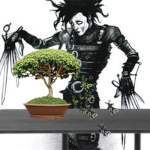Grafting Pine Branches
+3
Rob Kempinski
marcus watts
Dan W.
7 posters
Page 1 of 1
 Grafting Pine Branches
Grafting Pine Branches
Hi,
I'm curious whether any of you have experience grafting pine branches. I'm not very interested in grafting one tree to another base...(i.e. personally I don't really like the transition from rough JBP bark to smooth JWP)
I read that Michael Hagedorn grafted JBP branches on to one of his ponderosa's and it is doing very well. What I'm interested in is the possiblity of grafting other native species to ponderosa... rather than the Japanese species.
Does anyone have any experience grafting say... pinyon, mugo or lodgepole on to ponderosa branches? Even if not, what are your thoughts on this?
I will continue working with native ponderosa needles as well but I'm curious whether this might be a viable option for shorter needles.
Here is a link to Michael Hegedorn's JBP grafted Pondy.
http://crataegus.com/2011/04/25/blac...derosa-styled/
Thanks!
Dan
I'm curious whether any of you have experience grafting pine branches. I'm not very interested in grafting one tree to another base...(i.e. personally I don't really like the transition from rough JBP bark to smooth JWP)
I read that Michael Hagedorn grafted JBP branches on to one of his ponderosa's and it is doing very well. What I'm interested in is the possiblity of grafting other native species to ponderosa... rather than the Japanese species.
Does anyone have any experience grafting say... pinyon, mugo or lodgepole on to ponderosa branches? Even if not, what are your thoughts on this?
I will continue working with native ponderosa needles as well but I'm curious whether this might be a viable option for shorter needles.
Here is a link to Michael Hegedorn's JBP grafted Pondy.
http://crataegus.com/2011/04/25/blac...derosa-styled/
Thanks!
Dan

Dan W.- Member
 Re: Grafting Pine Branches
Re: Grafting Pine Branches
hi,
I'm interested in knowing something similar regarding grafting pine 'branches' too. My tree is all Japanese Black pine and i want to graft scions of the exact same tree back into some very bare inner sections. Timing is my question - you read late winter is the good time to make the grafts, but at this time the tree is needle plucked and thinned right out so the scions would not be ideal. (and could not be cut off as they are the branch tips needed where they are)
I'm guessing the best formed scions i could cut off are the hardened first growth candles from the summer pruning but would the tree accept these grafted in straight away?, would they stay viable wrapped in clingfilm in the fridge until winter? or do i need to let the tree grow freely unpruned in the summer to get scions from a winter pruning?
the actual methods i'm fine with, its the timing issue i'd be interested in hearing about.
thanks
Marcus
I'm interested in knowing something similar regarding grafting pine 'branches' too. My tree is all Japanese Black pine and i want to graft scions of the exact same tree back into some very bare inner sections. Timing is my question - you read late winter is the good time to make the grafts, but at this time the tree is needle plucked and thinned right out so the scions would not be ideal. (and could not be cut off as they are the branch tips needed where they are)
I'm guessing the best formed scions i could cut off are the hardened first growth candles from the summer pruning but would the tree accept these grafted in straight away?, would they stay viable wrapped in clingfilm in the fridge until winter? or do i need to let the tree grow freely unpruned in the summer to get scions from a winter pruning?
the actual methods i'm fine with, its the timing issue i'd be interested in hearing about.
thanks
Marcus

marcus watts- Member
 Re: Grafting Pine Branches
Re: Grafting Pine Branches
marcus watts wrote:hi,
the actual methods i'm fine with, its the timing issue i'd be interested in hearing about.
thanks
Marcus
When the scions are dormant and the tree is just starting to come out of dormancy. In Florida that is January. You can refrigerate the dormant scions to get ones prior to needle thinning or just plan ahead and don't mess too much with branches to be used as scions.

Rob Kempinski- Member
 Re: Grafting Pine Branches
Re: Grafting Pine Branches
Rob Kempinski wrote:marcus watts wrote:hi,
the actual methods i'm fine with, its the timing issue i'd be interested in hearing about.
thanks
Marcus
When the scions are dormant and the tree is just starting to come out of dormancy. In Florida that is January. You can refrigerate the dormant scions to get ones prior to needle thinning or just plan ahead and don't mess too much with branches to be used as scions.
Excelent, thanks Rob.
I've laid my hands on a lovely old JBP that has been allowed to run too wild for a few years so has lost inner density and buds. I've fully wired everything to give it a bit of shape, but mainly to stimulate back buds. I normally get loads of back buds but sometimes certain branches can be very stuborn so i was looking to grafting as a back up plan. As the timing of the other techniques on the main tree is quite critical to make the back buds i think the fridge will come into play.
cheers again,
Marcus

marcus watts- Member
 grafting pines
grafting pines
The main problem of grafting pinus syvestris is the oxidation of the sap, the last month to do is february in France , "when tree is just starting to come out of dormancy "( Rob )
An exemple: for cakoyers /therebenthe grafting ( brazil) , the scion must be grafted under water !!!!!
I think it'is not useful for conifers to put the grafts in the freezer before grafting, only for deciduous.
An exemple: for cakoyers /therebenthe grafting ( brazil) , the scion must be grafted under water !!!!!
I think it'is not useful for conifers to put the grafts in the freezer before grafting, only for deciduous.

abcd- Member
 Re: Grafting Pine Branches
Re: Grafting Pine Branches
Thanks everyone for your discussion. It sounds like many of you are partial to JBP or Scots. I will look hard at scots as a possible graft to ponderosa. Are there any others you would suggest trying? JBP is not hardy in my part of the country or I would give it more consideration. Are there any others you would suggest looking at?

Dan W.- Member
 Re: Grafting Pine Branches
Re: Grafting Pine Branches
hi Dan
I've grafted this ponderosa with scots pine. I prefer the smaller needles. The other drawback with this ponderosa was that its foliage was too far from the interesting trunk. You can see some of the ponderosa foliage in the right portion of the first frame. I approached two scots branches (in different years) and separated after one full year of growth. I'm sure it's safe to start removing the ponderosa foliage now. I'm preferring to wait a few years as I'm using it to develop a "layered" look with the wood that's going to be exposed in a few years. The following two images show the graft unions. With approach grafts, you want to have your placements in areas that are not going to be visible as they can be quite ugly. I'll be able to hide them with scots branches when I'm developing my cascade.
Good luck in your projects!



I've grafted this ponderosa with scots pine. I prefer the smaller needles. The other drawback with this ponderosa was that its foliage was too far from the interesting trunk. You can see some of the ponderosa foliage in the right portion of the first frame. I approached two scots branches (in different years) and separated after one full year of growth. I'm sure it's safe to start removing the ponderosa foliage now. I'm preferring to wait a few years as I'm using it to develop a "layered" look with the wood that's going to be exposed in a few years. The following two images show the graft unions. With approach grafts, you want to have your placements in areas that are not going to be visible as they can be quite ugly. I'll be able to hide them with scots branches when I'm developing my cascade.
Good luck in your projects!




peter keane- Member
 Re: Grafting Pine Branches
Re: Grafting Pine Branches
Thanks Peter, that helps a lot! The scots foliage is clearly a much better option for this pine, and I like where you're headed with the dsign.

Dan W.- Member
 Re: Grafting Pine Branches
Re: Grafting Pine Branches
[quote="peter keane"]
With approach graft, you want to have your placements in areas that are not going to be visible as they can be quite ugly. I'll be able to hide them with scots branches when I'm developing my cascade.
Peter,
In your approach grafts, did you just remove bark down to the cambium on both trees and bind them together? I'm thinking of carving a well into the ponderosa and inserting the JBP into the well to try and get a cleaner appearance. Any thoughts / insights?
With approach graft, you want to have your placements in areas that are not going to be visible as they can be quite ugly. I'll be able to hide them with scots branches when I'm developing my cascade.
Peter,
In your approach grafts, did you just remove bark down to the cambium on both trees and bind them together? I'm thinking of carving a well into the ponderosa and inserting the JBP into the well to try and get a cleaner appearance. Any thoughts / insights?
mbolos- Member
 Re: Grafting Pine Branches
Re: Grafting Pine Branches
I've never done anything like this but this is definitely the way I would do it if I am going to attempt one.mbolos wrote: I'm thinking of carving a well into the ponderosa and inserting the JBP into the well to try and get a cleaner appearance. Any thoughts / insights?

Poink88- Member
 Re: Grafting Pine Branches
Re: Grafting Pine Branches
mbolos
the bottom branch was grafted with a "tongued approach". The top was with an "inlay-approach" where you cut a groove or channel into the ponderosa and fit the scots shoot into it. You can research the two type of approach grafts. I tied hose clamps to the unions to prevent the shoots from moving. As you can see, the scots shoot grew higher than the ponderosa branch. that's why I'll have to hide it with foliage for showing. that's the drawback with approach grafting. the benefit is that it's more reliable than with bud, or side-veneer grafting.


the bottom branch was grafted with a "tongued approach". The top was with an "inlay-approach" where you cut a groove or channel into the ponderosa and fit the scots shoot into it. You can research the two type of approach grafts. I tied hose clamps to the unions to prevent the shoots from moving. As you can see, the scots shoot grew higher than the ponderosa branch. that's why I'll have to hide it with foliage for showing. that's the drawback with approach grafting. the benefit is that it's more reliable than with bud, or side-veneer grafting.



peter keane- Member
 Re: Grafting Pine Branches
Re: Grafting Pine Branches
[quote="peter keane"]mbolos
the bottom branch was grafted with a "tongued approach". The top was with an "inlay-approach" where you cut a groove or channel into the ponderosa and fit the scots shoot into it.
Peter, first off, thank you so much for sharing your experience. I had a few more questions:
(1) Did spring or fall grafts? Which season do you prefer?
(2) Which method of grafting (tongued, inlay, etc.) do you like best?
(3) For the inlay, did you cut a V in both?
(4) For the tongued approach, did you just use a chisel to get under the Ponderosa's bark?
the bottom branch was grafted with a "tongued approach". The top was with an "inlay-approach" where you cut a groove or channel into the ponderosa and fit the scots shoot into it.
Peter, first off, thank you so much for sharing your experience. I had a few more questions:
(1) Did spring or fall grafts? Which season do you prefer?
(2) Which method of grafting (tongued, inlay, etc.) do you like best?
(3) For the inlay, did you cut a V in both?
(4) For the tongued approach, did you just use a chisel to get under the Ponderosa's bark?
Last edited by mbolos on Tue Mar 13, 2012 3:11 am; edited 1 time in total
mbolos- Member
 Re: Grafting Pine Branches
Re: Grafting Pine Branches
mbolos:
I'll bud, or side-veneer graft in later winter. With approach grafing, it's during mid-spring when both the root stock and donor stock are out of dormancy. The grafting I like the best is bud and side-veneer since the graft unions are cleaner. you get better placements, too. but the yield isn't as high as with approach grafting. With the inlay graft on the ponderosa, I didn't cut a "v" into the ponderosa wood. I used a Dremel with a wood carving bit to clear out a channel for packing the scots shoot. After the Dremel was used, I cleaned the edges with my grafting knife. This removed any fuzz and burned wood. Then, I cut the bottom of the scots shoot to ensure that it would not "grow" and push itself out of the slot. I carefully removed the bark from the sides of the shoot, then, pressed it into the slot. The ponderosa's phloem layer is much thicker than the smaller scots shoot. So, I had to cut pretty deep into the ponderosa to ensure that its cambium would make contact with the much smaller scots. You can see how the scots was held for a year. With the tongued-approach method, I first scraped off the flaking bark with a jin blade. then, I used a folding grafting knife to expose the cambium later. While cutting into the ponderosa, my knife actually bent back at the hinge. I won't use folding grafting knifes anymore. The length of the cut was an inch. I first marked the area with a felt pen on both, the scots and ponderosa to ensure a good fit. As the ponderosa cut was wider than the scots, I had to place the scots to one side of the ponderosa cut. This ensured cambium contact between the two. it's also a good idea to hold back water a bit with pines. This keeps the pitch to a minimun after the cambium is exposed.
Tomorrow, I'll be grafting shimpaku to a friend's prostrata juniper. This is the second round with this tree.
I'll bud, or side-veneer graft in later winter. With approach grafing, it's during mid-spring when both the root stock and donor stock are out of dormancy. The grafting I like the best is bud and side-veneer since the graft unions are cleaner. you get better placements, too. but the yield isn't as high as with approach grafting. With the inlay graft on the ponderosa, I didn't cut a "v" into the ponderosa wood. I used a Dremel with a wood carving bit to clear out a channel for packing the scots shoot. After the Dremel was used, I cleaned the edges with my grafting knife. This removed any fuzz and burned wood. Then, I cut the bottom of the scots shoot to ensure that it would not "grow" and push itself out of the slot. I carefully removed the bark from the sides of the shoot, then, pressed it into the slot. The ponderosa's phloem layer is much thicker than the smaller scots shoot. So, I had to cut pretty deep into the ponderosa to ensure that its cambium would make contact with the much smaller scots. You can see how the scots was held for a year. With the tongued-approach method, I first scraped off the flaking bark with a jin blade. then, I used a folding grafting knife to expose the cambium later. While cutting into the ponderosa, my knife actually bent back at the hinge. I won't use folding grafting knifes anymore. The length of the cut was an inch. I first marked the area with a felt pen on both, the scots and ponderosa to ensure a good fit. As the ponderosa cut was wider than the scots, I had to place the scots to one side of the ponderosa cut. This ensured cambium contact between the two. it's also a good idea to hold back water a bit with pines. This keeps the pitch to a minimun after the cambium is exposed.
Tomorrow, I'll be grafting shimpaku to a friend's prostrata juniper. This is the second round with this tree.

peter keane- Member
 Similar topics
Similar topics» pine grafting
» pine grafting questions
» Root grafting Scots Pine ?
» Grafting mugo shots into a montezunae and mexican white pine(ayacahuite)
» Pine cones on Japanese White Pine. Should they be removed?
» pine grafting questions
» Root grafting Scots Pine ?
» Grafting mugo shots into a montezunae and mexican white pine(ayacahuite)
» Pine cones on Japanese White Pine. Should they be removed?
Page 1 of 1
Permissions in this forum:
You cannot reply to topics in this forum






